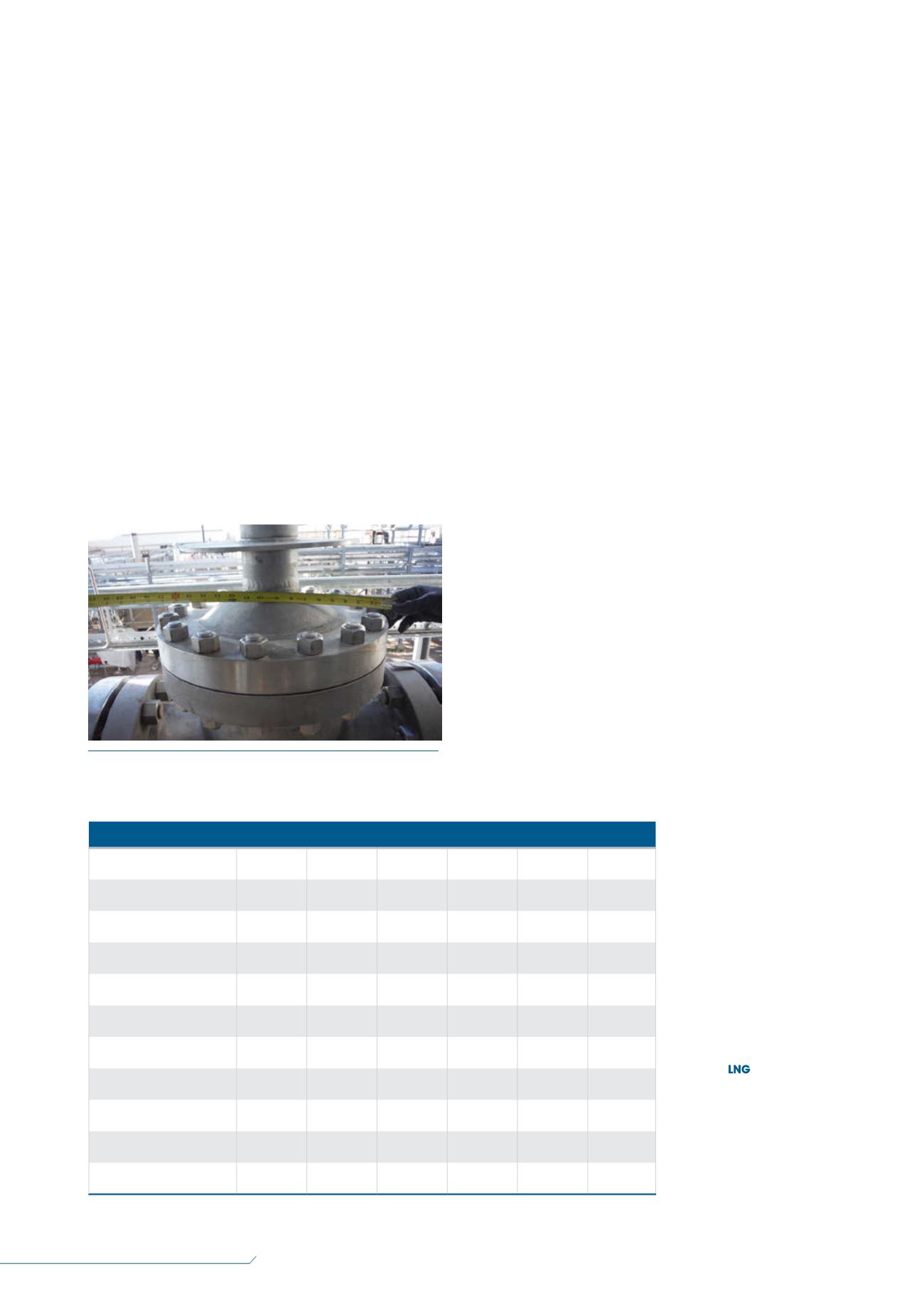
74
LNG
INDUSTRY
APRIL
2016
Case study
During the construction of a new LNG plant in Evanston,
Wyoming, US, a gate valve was left uninsulated. Gate
valves, flanges, and other components are often left
uninsulated at LNG plants, due to the fact that regular
maintenance must be performed.
Although it proves costly to reinsulate the valve, it is
also costly to leave it uninsulated. An analysis of the
component shows that it is a traditional 8 in. 600 lb
(ANSI class) gate valve. Careful measurements were taken
and the surface area of the valve was calculated at 18.86 ft
2
(Figure 1).
After running a heat loss analysis, with an ambient
temperature of 55°F (the average temperature in the region)
and a process temperature of -260°F, the heat gain will be
1306 Btu per hr per ft
2
. When this number is multiplied by the
surface area of the valve and the proper unit conversions are
made, the annual heat gain within this single gate valve is
215.77 million Btu/yr. Liquefaction represents approximately
20% of the total cost of LNG, including the supply chain and
the plant itself. When applied to the cost of the entire
process, an annual heat gain of 215.77 million Btu will lose
approximately US$2300/yr.
Removable insulation and
energy savings
A solution to losing thousands of dollars per year in valves
that cannot be traditionally insulated can be found by using
removable, reusable, cryogenic insulation jackets. Multiple
layers of Cryogel-Z, developed by Aspen Aerogels, are
assembled inside a polytetrafluoroethylene (PTFE) coated
fibreglass cloth to create the removable insulation. This
insulation is specially engineered for cryogenic applications
and has a k-value at -260°F of 0.090 Btu.in/hr.ft
2
°F. The low
thermal conductivity of the insulation allows for improved
efficiency and energy savings within the valve.
With 50 mm of Cryogel-Z, the heat gain of the gate
valve is reduced by 100 times to just 2.16 million Btu/yr.
When properly insulated, the cost associated with an energy
loss this small becomes negligible. In order to ensure that
the valve remains properly insulated, the jacket must be as
air tight as possible. Although the insulation has a built in
vapour barrier, the unusual shape of a gate valve makes this
difficult.
To prevent airflow, several different jackets are needed
to properly insulate the gaps between the flanges and any
existing pipe insulation around the jacket. Once the gaps are
properly filled to reduce air flow, one large cryogenic jacket
covers the entire valve body, and another large cryogenic
jacket covers the entire valve bonnet. With a proper fitting
jacket, a plant can save over 200 million Btu/yr on just one
gate valve.
Conclusion
As the LNG industry continues to grow, more plants are
being developed around the world to provide import and
export terminals for LNG. Even in the smaller plants, it is not
uncommon to see 500 uninsulated valves and flanges. If the
average uninsulated component is the same size as the one
in this case study, a plant with 500 valves and flanges can
lose over 100 000 million Btu/yr, or US$1 million/yr.
In order to avoid these losses, LNG valves must be
insulated. Traditional cryogenic insulation techniques can be
used on the valves, but
each time they need to be
serviced, they will need to
be reinsulated. Over time,
this will become
expensive for the plant. An
alternative solution is
removable, reusable
cryogenic insulation
jackets. With an average
return on investment (ROI)
of less than 2 years,
cryogenic jackets are an
effective solution for
providing significant
savings.
Reference
1. NERA Economic
Consulting:
Macroeconomic
Impacts of LNG
Exports from the
United States.
Table 2.
The total liquefaction fixed cost per million Btu produced in different regions of the world
1
2010
2015
2020
2025
2030
2035
Africa
US$3.37 US$3.38 US$3.40 US$3.42 US$3.44 US$3.46
Canada
US$3.85 US$3.88 US$3.93 US$4.02 US$4.06 US$4.15
Central and South America US$2.71
US$2.73 US$2.75 US$2.77 US$2.79 US$2.82
Europe
US$3.35 US$3.43 US$3.50 US$3.61
US$3.65 US$3.72
FSU
US$2.65 US$2.65 US$2.67 US$2.68 US$2.70 US$2.71
Middle East
US$2.81
US$2.82 US$2.84 US$2.85 US$2.87 US$2.88
Oceania
US$4.22 US$4.23 US$4.25 US$4.27 US$4.29 US$4.31
Sakhalin
US$2.65 US$2.65 US$2.67 US$2.68 US$2.70 US$2.71
Southeast Asia
US$3.73 US$3.74 US$3.76 US$3.79 US$3.81
US$3.84
US
US$2.13 US$2.14 US$2.18 US$2.25 US$2.28 US$2.34
Figure 1.
The surface area of the gate valve at the LNG plant in
Evanston, US, is 18.86 ft
2
.


